The Status of the F-35 Programme
News item
The Finnish Defence Forces are experiencing a time of great changes. Finland gaining NATO membership in April has been the main story, but much more is going on. The Commander of the Air Force, Major General Juha-Pekka Keränen, tells us what is currently happening in the F-35 Programme.
After the procurement decision made in December 2021 and the first contracts signed in February 2022, the F-35 Programme has seemed to be fairly quiet from an outsider's perspective, but underneath things are happening. Work is carried out both in Finland and in the United States, and the integration of the joint capability of the Defence Forces – Joint Fighter – has progressed to the performance-building stage.
The F-35 Programme is being prepared by a separate body, but the results of the programme will be visible in a defence-oriented manner. An F-35 Programme organisation has been established in the Air Force, but otherwise the defence administration's rules of procedure have remained the same for the programme, being largely the same as in the HX Programme during the evaluation of the fighter candidates.
– Generally speaking, the implementation of the F-35 Programme is progressing as planned. In practice, we have continued with the same division of labour as during the evaluation of the HX Programme's fighter candidates. The Air Force Command directs the integration of the F-35 capability. This means that the Air Force Command directs the building and achievement of capability. In other words, their task is to make sure that the framework required for the operation of the F-35 is completed and the combat-efficiency is achieved on time, says the Commander of the Air Force, Major General Juha-Pekka Keränen.
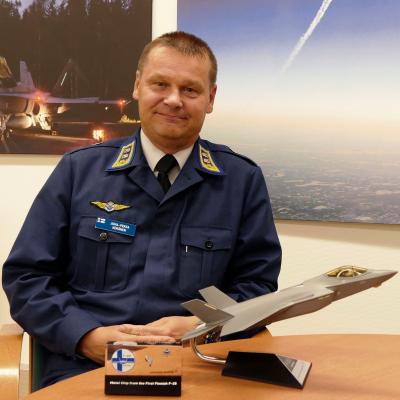
Major General Juha-Pekka Keränen has served as the Commander of the Finnish Air Force since June 2022. Photo: Finnish Air Force
The Defence Forces Logistics Command is responsible for the trade processes of the programme and is building the maintenance system of the F-35 together with the Finnish industries and the Air Force Command. The Logistics Command is responsible for the procurement of the fighters, weapons and other system-related products and services.
The Ministry of Defence is responsible for industrial cooperation as a whole. Industrial cooperation agreements are built under the direction of the ministry. The ministry negotiates and supervises the whole in such a way that the 30 per cent share of the total value of the procurement set as a requirement for the value of industrial cooperation during the tendering phase of the programme is realised.
According to Keränen, keeping to the schedule is crucial to the F-35 Programme.
– It is important to ensure that we keep to the planned schedule. That all parties of the programme, including the partners, adhere to the planned and agreed schedule and that the contracts on the content of the tenders will keep to what has been promised to us. In this transitional phase, it is important for us to plan and prepare for operational use as much as possible in advance.
Construction and training as topical issues
In the Finnish Air Force, the focus of the F-35 Programme is currently on the planning and launching of construction projects and the planning and preparation of training. The construction work on the infrastructure of the Defence Forces bases is still largely carried out at planning tables and with site surveys on bases.
– In the construction of an air force base, we comply with the manufacturer's and the US Government's regulations on the safety requirements for structures. The US Government uses the SATAF (Site Activation) process to ensure that buildings meet the information security requirements of the 2030s. In these processes, we will review, among other things, the special security requirements for the F-35, which it has, especially in terms of information and operational security. We will examine the safety requirements of the F-35 and plan what kind of special security facilities are needed for our bases in normal and emergency conditions, Keränen explains.
In addition to planning and preparation, actual construction work is already underway.
– At the Rovaniemi Air Base of Lapland Air Wing, construction work has begun now in September. Underground excavation and construction work are ongoing. At Karelia Air Wing’s Rissala Air Base some finished work can already be seen: a new arresting cable has been built on the airfield, half of the military apron has been fixed, and the other half will be built next summer. The runway and taxiways will also be paved as a part of normal renovation work by Finavia. As far as construction is concerned, there is nothing to see yet at Lapland Air Wing, but at Rissala, the arresting cable that has replaced the barrier net is a visible aspect of the construction related to the F-35 Programme, comments Keränen.
The planning and preparation of initial training in the United States are also staunchly under way, and the training plans are being clarified.
– The details of the training arrangement agreements have been fine-tuned and the training plans have been specified. As the latest measure, at the end of August I approved the proposal for Air Force personnel to go to initial training.
Pilots and aircraft maintenance personnel will go to the United States for initial training. Flight training will take place at Ebbing Air National Guard Base (ENGB) in Fort Smith, Arkansas. The same base also trains F-35 personnel from Poland, Germany, Switzerland and Singapore. The F-35 system's theoretical and simulator training will be provided at Eglin Air Force Base (Eglin AFB) in Florida. The Eglin base also trains the US Air Force personnel. For security reasons, the Air Force will keep the personnel selected for the initial training out of the public eye.
– We will ensure operational security, so we will not publish the names of the detachment leaving for the initial training. The selected personnel know about their departure and can start preparing for the training in the United States, says Keränen.
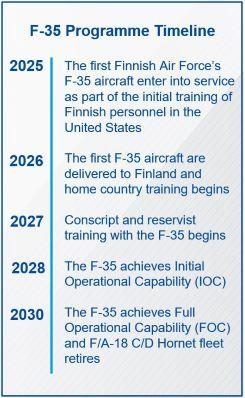
The first fighters will be delivered to Finland in 2026. Photo: Finnish Air Force
The training for pilots and aircraft maintenance personnel will start in 2025 in the United States and in 2026 in Finland.
– The year 2026 will be significant for training as the training begins in Finland, right after the summer holidays. We aim to get started with simulator training as soon as the first planes and pilots are received from the United States to Finland. This will enable us to ensure that the pilots of Lapland Air Wing can be trained to use this new fleet of fighters as quickly as possible. The US-trained aircraft maintenance personnel of Lapland Air Wing will in turn train more maintenance personnel in Finland, explains Keränen.
Operational capability for the whole defence system
The F-35 system will affect the entire Defence Forces, so preparations will be made for its introduction into service and integration into the defence system also outside the Air Force. Developing the Defence Forces is a whole, and the F-35 is one part of this whole. Finland's recent NATO membership, the ongoing Pohjanmaa-class vessel programme of the Navy, the Finnish Army GBAD Capability Replacement Programme (ITSUKO), the Air Force IITVJ (Integrated C4ISR System) programme and, of course, the F-35 Fighter Programme will all have a significant impact on air defence and the entire defence system in the coming years.

The F-35 will become a key player in the Finnish defence system. In the picture, a US F-35 with Air Force Hornets over Tampere in the summer of 2022. Photo: Finnish Air Force
In addition to the integration of the F-35 into the Air Force, the ongoing IITVJ Programme will increase the capabilities of the C4ISR systems of the Air Force in the 2030s. Apart from the Air Force, the Finnish Navy and the Army are also building key capabilities for air defence. The Pohjanmaa-class vesselprogramme of the Navy is moving forward towards the construction phase of multi-role corvettes. In spring 2023, a procurement decision was made on the high-altitude capability for ground-based air defence for the Army. The chosen system was the David's Sling missile system, which will also provide a new aspect to air defence.
The F-35 capability will have a joint impact, and the integration of the F-35 into the defence system will also be visible throughout the Defence Forces. Cooperation within the Defence Forces is close, and under the leadership of the Plans and Policy Division of the Defence Command, the F-35 has been linked to the strategic planning of the Defence Forces, i.e. the planning of the future and future operations of the Defence Forces.
– Under the leadership of the Defence Command’s Plans and Policy Division, the requirements the F-35 places on the Army, Navy, C4IS systems and intelligence have been reviewed so that we can support the entire defence system as well as possible. The Defence Command focuses on how the services work together as efficiently as possible. In other words, we are moving towards multi domain operations. I consider the F-35 to be a good choice for Finland. It brings significant capability to Finland's defence and supports the entire defence system – ground, sea and air combat, states Keränen.
Seamless cooperation between the services is important.
– In the Defence Forces, the design of the F-35 concept is largely the design of actual operating principles. Cooperation in this part has been going smoothly. There have been no actual surprises for the services in the planning of the use of the shared capability. The services have been constantly informed about the programme and the use of the F-35 and the opportunities it will bring, so nothing has really come as a surprise to anyone. During these major changes, cooperation within the Defence Forces has been very good, open and smooth. Together, we are planning how we will defend Finland in the 2030s and how each of us will factor into this whole, says Keränen.
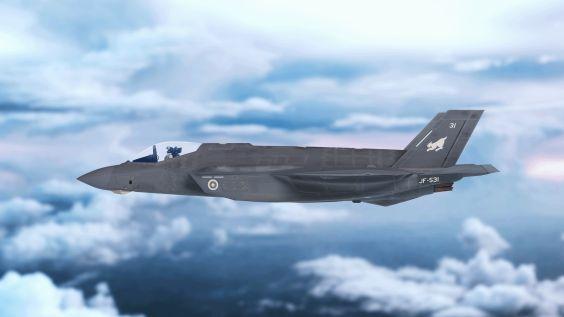
An image of the paint scheme of the Finnish F-35, Joint Fighter. The picture is a sketch and the final size and exact locations of the markings will be determined in the detailed design of the painting diagrams. Photo: Finnish Air Force
The requirements and operating principles for the Hornet capability replacement system were already devised during the HX Programme, so the operating concept of the new weapon system was clear before the procurement decision was made. Since then, the principles of the F-35 operational use as a part of the defence system have been specified. All HX candidates provided information on the system integration requirements for the Finnish defence system already at the evaluation stage of the HX Programme, so the general basis for integration was already in place at the time of the procurement decision.
– After the procurement decision, we received clarifications on these integration requirements for the F-35 from the US Government, represented by the Joint Program Office (F-35). The work is being carried out throughout the Finnish Defence Forces to ensure that the F-35 system can be integrated into the Finnish defence system as smoothly as possible, explains Keränen.
Specific requirements and operating principles have already been practiced.
– In the spring, a joint war game was conducted under the leadership of the Air Force, modelling the capabilities the Defence Forces will have in use in the 2030s and examining how the F-35 supports the defence system. The use of the F-35 in operational tasks was modelled, and what specifically the F-35 brings to the defence system, was modelled in this war game. In other words, the war game modelled a very concrete joint operation, which has to be planned well. For example, there must be interoperable leadership systems in place in order for us to be able to operate in real time, Keränen elaborates.
Finland closely involved in the multinational community
The F-35 has been designed to be a multinational programme, and Keränen feels that Finland has been very successful in joining the global F-35 user community. Finland has been involved in the user community since February 2022, when the first F-35 contracts were concluded. Keränen participated in the meeting of the Commanders of the Air Forces of the F-35 user countries for the first time already in spring 2022, substituting for the then-Commander of the Air Force, Major General Pasi Jokinen. The spirit of the meeting was good and the exchange of information was effective.
Transparency to the user community has been significant from the start. The F-35 user community has working groups, of which Finland focuses on themes that it considers particularly important.
– Of the working groups of the F-35 user community, we are particularly interested in the development of the F-35, operating the aircraft and logistics at the moment. Observations related to operations and logistics are particularly important to us. For the Air Force, observations about operational use are essential, and for the Defence Forces Logistics Command, observations about logistics, such as the shared spare parts reserve of the user countries, are key. We are keen to hear the lessons learned and development areas identified by other user countries, such as how to operate most efficiently during the transition period, i.e. when we have both the new F-35 fighters and the existing Hornets in use, says Keränen.

Finnish F-35s and Hornets will operate side by side until 2030 when the F-35 reaches full operational capability and the Hornets have retired. In the picture, a Finnish Air Force Hawk Mk 66 and Hornet with a US F-35 in Pirkanmaa in the summer of 2022. Photo: Finnish Air Force
The joint spare part reserve of F-35 user countries is a part of Lockheed Martin's Global Support Solution (GSS) system, where the user countries have access to F-35's shared spare part pool, i.e. the reserve. The joint spare parts reserve provided by the global maintenance arrangement is central to the security of supply, which is also supported by the spare parts and replaceable component reserve to be created in Finland for emergency conditions.
In addition to learning and arrangements related to security of supply, the user community also has other benefits.
– The European user community has benefits such as cross-education and cross-operation. In exercises and operational use, the pilot may land in another country, commission the necessary line maintenance measures there and then continue on their way.
The Commander of the Air Force believes that the F-35 user community is also an important resource for NATO.
– In the 2030s, the F-35 will be the main weapon system for European air forces. At that time, there will be seven hundred F-35 fighters in Europe, of which fifty will belong to the United States. This number of F-35 aircraft is significant for NATO, Keränen explains.
Keränen sees NATO's role in the F-35 user community as moderate.
– The majority of European F-35 users are NATO countries, but we are also openly discussing F-35 development issues with Switzerland, says Keränen.
No need to hurry the changes
The F-35 Programme is about a large whole, the largest defence materiel procurement ever in Finland. The Commander of the Air Force takes a calm stance on this great responsibility.
– I don't really have anything to worry about in the programme, says Major General Keränen.
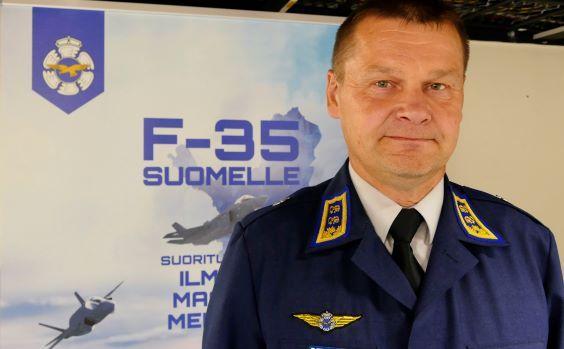
The Commander of the Air Force is the most confident about the progress of the F-35 Programme. Photo: Finnish Air Force
However, the global situation also has an impact on the F-35 Programme.
– Of course, Russia's brutal attack on Ukraine and the resulting inflation are all worrisome issues. The so-called race for defence materiel has increased the prices exceptionally, especially last year. The defence industry has a seller's market, and of course we monitor the availability and prices of weapons.
Global and Finnish economic prospects have not been very glamorous in recent years. The F-35 Programme is prepared for changes in the economies of the United States and Finland.
– We are constantly monitoring the economic situation. The procurements of the F-35 Programme will take place over several years. The economic situation will probably normalise before long. The programme has prepared for economic changes by reimbursing the index costs accumulated over the years on top of the purchase price in accordance with the European calculation method, to give an example. If the costs increase faster than the index to be compensated, then we have to react, but we are constantly monitoring this. I wouldn't worry too much about this yet, Keränen comments.
In addition to the economic situation, the F-35 Programme has also monitored the Russian war of aggression in Ukraine. According to Keränen, there is no need to change the F-35 Programme plan or the operations of the Air Force on the basis of the observations made during the war.
– The same principles defined for the evaluation phase of the HX Programme continue to apply: The Air Force must have dispersed operations, the ability to react quickly, and we must be able to support the Army and the Navy in terms of situational awareness, intelligence and fire use in real time. It is essential to fit air, ground and sea combat into the whole, especially as the Army will be gaining new ground-based air defence systems within the next decade, such as the David's Sling already in this decade.
The system development of the F-35 has been occasionally highlighted in international and domestic media. The points of interest have been, among other things, what kind of radar and engine the F-35 fighters acquired by Finland will have. The production details of the F-35 are being negotiated in the United States through FMS procedures. Foreign customers trading with the US Government are so-called Foreign Military Sales (FMS) customers. In the United States, there is an F-35 Programme office, JPO (Joint Program Office), through which all customers do business related to their F-35 Programmes. Finland has a small liaison office on site to promote the implementation of the Finnish programme.
– The Air Force does not negotiate directly with Lockheed Martin, but with the US Government in accordance with the FMS rules. We can count on JPO to negotiate the best solutions for us, the same solutions that the US Air Force has, Keränen says.
The JPO programme office serves as a link between the customer, the supplier and the US Government. The JPO manages and negotiates matters related to the Finnish F-35 Programme with Lockheed Martin and the US Government. Consequently, the personnel of the Finnish F-35 Programme only have to deal with the Finnish liaison office.
– The Defence Forces are represented at the JPO Liaison Office by Colonel Aki Heikkinen, who functions as the messenger of the Finnish F-35 Programme in the United States. As far as product development in the F-35 Programme is concerned, our aim is to monitor the F-35 system administrator, the US Air Force, as closely as possible. This is cost-effective, as the administrator also pays for most of the system development work. However, I would not go too far here to speculate on the impacts of F-35's development work on the Finnish fighters, such as whether there will be divergent development paths or something else, says Keränen.
Information on development and production does not serve any surprises to the Air Force, as cooperation and exchange of information with the United States is continuous. In addition to internal communications, information from the U.S. Government is disseminated by the U.S. Government Accountability Office GAO. Keränen considers the Accountability Office's reporting related to the F-35 Programme to be transparent.

Lockheed Martin displayed F-35 fighter jets at the Turku Air Show in the summer of 2023. Photo: Finnish Air Force
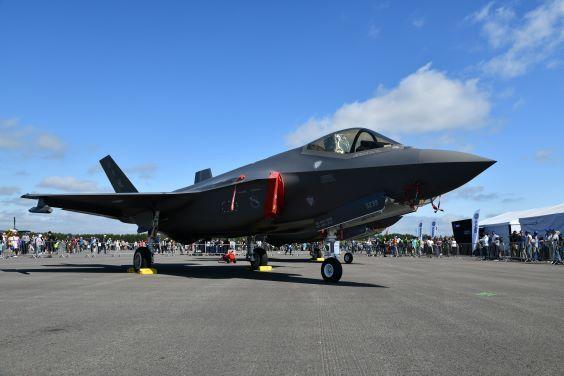
Photo: Finnish Air Force
In addition to the development, the F-35 Programme keeps a constant eye on the horizon, as the capability replacing the Hornet is expected to serve until the 2060s. During the life cycle of the system, upgrades will be made as planned.
– The planning criteria for the programme allocates EUR 2 billion for in-service upgrades of the selected fighter system. This will be covered by the defence budget in due course. In other words, we will be upgrading the F-35 during its life cycle, says Keränen.
Moving forward together - keeping to the schedule
According to the Commander of the Air Force, the schedule of the F-35 Programme looks currently promising.
– The programme is proceeding as planned. Certain milestones have been set, and an important time limit is the launch of domestic training in Rovaniemi in early autumn 2026, beginning with simulator training. Keeping to the schedule requires that we are on the same wavelength with our partners, so to speak. I believe that we share a strong common desire and understanding with our partners of what needs to be achieved and in what timeframe.
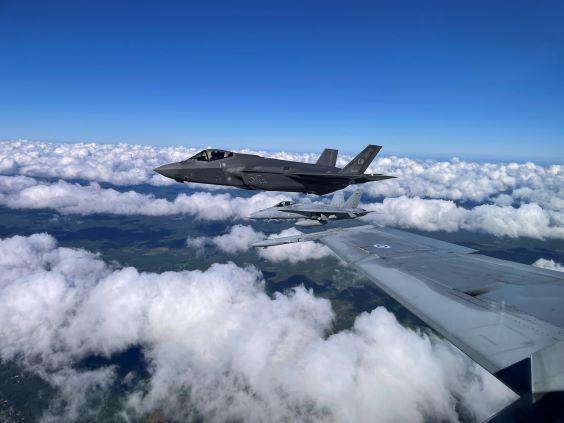
The F-35 Programme has progressed as planned. The picture shows a US F-35 and Air Force Hornets in Finland in the summer of 2022. Photo: Finnish Air Force
The schedule for the F-35 Programme for Finland has been called ambitious. The Commander of the Air Force understands the logical reasons behind the firm schedule.
– In the Air Force, the HX Programme lasted seven years, and at the time of the tendering process, we already carried out a lot of research in the evaluation process of the fighter candidates, for example in terms of safety requirements, which has had an impact on the fact that we have now been able to cut one to two years from the integration stage of the programme. The Finnish planning mechanism progresses well once it has been launched, explains Keränen.
Like all programmes, the schedule of the F-35 Programme also takes into account unexpected delays.
– There can always be an unexpected problem which delays the programme. We must always be prepared for unexpected things.
When asked about the timing of the next weapons procurements, the Commander of the Air Force remains moderate.
– The first weapons contracts have been concluded, and now we will take our time. It remains to be seen whether decisions on the next weapons procurements will be made this year. In the future, decisions will probably be made every year on one thing or another.
Decisions on the procurement of weapons for F-35 fighters are scheduled over several years and stretched to the future in order to enable the supply of up-to-date and modern weapons. According to Keränen, there is no need to worry about the availability of weapons.
– The US Congress's exemptions for weapons sold to Finland have, as it were, placed us in the queue for the acquisition of those weapons. There is no rush to procure weapons, and we are deliberately stretching procurement decisions into the future so that we can follow the trends in weapons development and ensure that we can, if we wish, acquire the most up-to-date weapons with the longest possible lifecycle. In addition, the weapons used in the Hornet are also suitable for the F-35 fighters, which will enable us the use of weapons in stock also on the F-35s.
Historic times
Although the F-35 Programme is about the usual long-term strategic planning of the Finnish Defence Forces and the replacement of ageing capabilities, it is nevertheless the most valuable defence materiel procurement in the history of Finland. How does it feel to be the Commander of the Air Force during these historic moments?
– This is an interesting period, of course. In addition to the F-35 Programme, the Air Force and the Finnish Defence Forces are experiencing other major changes, such as Finland's NATO membership, which was ratified in the spring, and the related requirements to harmonise Finland as a part of NATO. Preparations are being made in working groups so that the programmes and the NATO integration can be finalised. Once capacity is implemented, the results will be visible to everyone. All services will have access to the F-35 and IITVJ's capabilities as well as to the interesting tasks available in the NATO organisation. So yes, there is plenty to do, but I am sure it will be interesting for everyone. Times are indeed interesting, says Keränen.
The progress of the F-35 Programme has become more real this year not only in construction but also in production. The first Finnish F-35 fighter is in production at the Lockheed Martin’s plant in Fort Worth, Texas, USA. Small details tell of the start of production: in the summer of 2023, Major General Keränen was ceremoniously handed a piece of Finland's first F-35 aircraft at the Turku Air Show. It is a physically small metal spiral, but symbolically a significant step in the progress of the F-35 Programme.
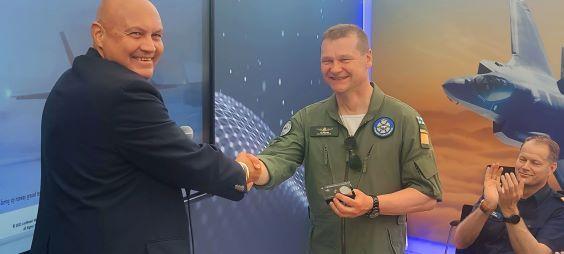
The Commander of the Air Force received one piece of Finland's first F-35 fighter at the Turku Air Show in the summer of 2023. The piece was handed over by Scott Davis from Lockheed Martin. Photo: Finnish Air Force
– It certainly feels great and makes the progress of the programme more evident when one has received a piece of Finland’s first F-35. This also makes real the fact that the finished product is slowly starting to come together and that we are progressing towards the target on schedule.
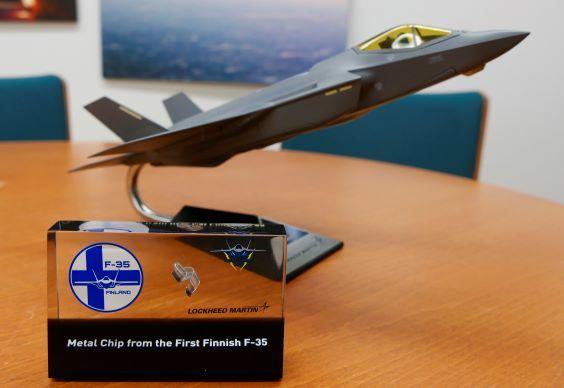
Photo: Finnish Air Force



